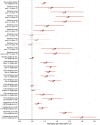Factors associated with baseline mortality in Norwegian Atlantic salmon farming
- PMID: 34282173
- PMCID: PMC8289829
- DOI: 10.1038/s41598-021-93874-6
Factors associated with baseline mortality in Norwegian Atlantic salmon farming
Abstract
In 2019, it was estimated that more than 50 million captive Atlantic salmon in Norway died in the final stage of their production in marine cages. This mortality represents a significant economic loss for producers and a need to improve welfare for farmed salmon. Single adverse events, such as algal blooms or infectious disease outbreaks, can explain mass mortality in salmon cages. However, little is known about the production, health, or environmental factors that contribute to their baseline mortality during the sea phase. Here we conducted a retrospective study including 1627 Atlantic salmon cohorts put to sea in 2014-2019. We found that sea lice treatments were associated with Atlantic salmon mortality. In particular, the trend towards non-medicinal sea lice treatments, including thermal delousing, increases Atlantic salmon mortality in the same month the treatment is applied. There were differences in mortality among production zones. Stocking month and weight were other important factors, with the lowest mortality in smaller salmon stocked in August-October. Sea surface temperature and salinity also influenced Atlantic salmon mortality. Knowledge of what affects baseline mortality in Norwegian aquaculture can be used as part of syndromic surveillance and to inform salmon producers on farming practices that can reduce mortality.
© 2021. The Author(s).
Conflict of interest statement
The authors declare no competing interests.
Figures







Similar articles
-
The economic impact of decreased mortality and increased growth associated with preventing, replacing or improving current methods for delousing farmed Atlantic salmon in Norway.Prev Vet Med. 2023 Dec;221:106062. doi: 10.1016/j.prevetmed.2023.106062. Epub 2023 Nov 2. Prev Vet Med. 2023. PMID: 37939576
-
Estimating cage-level mortality distributions following different delousing treatments of Atlantic salmon (salmo salar) in Norway.J Fish Dis. 2021 Jul;44(7):899-912. doi: 10.1111/jfd.13348. Epub 2021 Feb 19. J Fish Dis. 2021. PMID: 33606885
-
Effect of cleaner fish on sea lice in Norwegian salmon aquaculture: a national scale data analysis.Int J Parasitol. 2020 Sep;50(10-11):787-796. doi: 10.1016/j.ijpara.2019.12.005. Epub 2020 Feb 7. Int J Parasitol. 2020. PMID: 32035989
-
Cardiomyopathy syndrome in Atlantic salmon Salmo salar L.: A review of the current state of knowledge.J Fish Dis. 2018 Jan;41(1):11-26. doi: 10.1111/jfd.12735. Epub 2017 Oct 24. J Fish Dis. 2018. PMID: 29064107 Review.
-
Complex Gill Disease: an Emerging Syndrome in Farmed Atlantic Salmon (Salmo salar L.).J Comp Pathol. 2018 Aug;163:23-28. doi: 10.1016/j.jcpa.2018.07.004. Epub 2018 Aug 16. J Comp Pathol. 2018. PMID: 30213370 Review.
Cited by
-
A Colorimetric Approach for Detecting a Selected Fecal Cortisol Metabolite as a Stress Biomarker in Atlantic Salmon.ACS Omega. 2025 Jun 13;10(24):25271-25284. doi: 10.1021/acsomega.4c10562. eCollection 2025 Jun 24. ACS Omega. 2025. PMID: 40584319 Free PMC article.
-
Spatiotemporal patterns of mortality events in farmed Atlantic salmon in British Columbia, Canada, using publicly available data.Sci Rep. 2024 Dec 30;14(1):32122. doi: 10.1038/s41598-024-83876-5. Sci Rep. 2024. PMID: 39738537 Free PMC article.
-
Quantitative Genetics of Smoltification Status at the Time of Seawater Transfer in Atlantic Salmon (Salmo Salar).Front Genet. 2021 Nov 1;12:696893. doi: 10.3389/fgene.2021.696893. eCollection 2021. Front Genet. 2021. PMID: 34790218 Free PMC article.
-
Associations Between Delousing Practices and Pasteurellosis in Farmed Atlantic Salmon.J Fish Dis. 2025 May;48(5):e14085. doi: 10.1111/jfd.14085. Epub 2025 Jan 27. J Fish Dis. 2025. PMID: 39868606 Free PMC article.
-
Exploring Options for Syndromic Surveillance in Aquaculture: Outbreak Detection of Salmon Pancreas Disease Using Production Data from Norwegian Farms.Transbound Emerg Dis. 2024 Apr 30;2024:9861677. doi: 10.1155/2024/9861677. eCollection 2024. Transbound Emerg Dis. 2024. PMID: 40303021 Free PMC article.
References
-
- SERNAPESCA (Servicio Nacional de Pesca y Acuicultura). Informe Sanitario de Salmonicultura. http://www.sernapesca.cl/sites/default/files/informe_sanitario_salmonicu... (2018).
-
- Sommerset, I. et al.The Health Situation in Norwegian Aquaculture 2019. https://www.vetinst.no/rapporter-og-publikasjoner/rapporter/2020/fiskehe... (2020).
-
- Grefsrud, E. S. et al.Risikorapport norsk fiskeoppdrett 2021—risikovurdering. https://www.hi.no/hi/nettrapporter/rapport-fra-havforskningen-2021-8 (2021).
Publication types
MeSH terms
LinkOut - more resources
Full Text Sources

